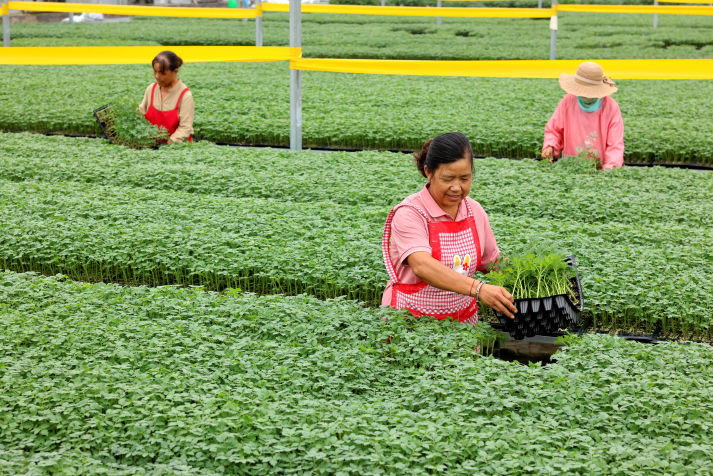
The Global Leaders’ Meeting on Women, known as “Beijing +30,” was held on October 13-14 to commemorate the 1995 Fourth World Conference on Women held in Beijing 30 years ago. Ahead of the meeting, Beijing Review interviewed Karen Martinez, a strategic planning specialist at the Center for Sustainable Agricultural Mechanization (CSAM), part of the United Nations Economic and Social Commission for Asia and the Pacific (ESCAP). In the interview, Martinez shared insights into how UN-China cooperation is advancing sustainable agriculture and empowering rural women across the Asia-Pacific region. Edited excerpts of the interview follow:
Beijing Review: Could you elaborate on the cooperation between the CSAM and China in the agricultural sector, and how the two sides work together to promote the development of agriculture in the Asia-Pacific region?
Karen Martinez: I think it’s important to first highlight the role that the CSAM plays as part of the UN. We are a regional institution, part of the ESCAP. And our main role is to improve rural livelihoods, reduce poverty and advance sustainable agricultural mechanization.
The Government of China is one of our key partners in all the activities that we are able to do. Currently, we have a project that is related to straw management. This project tries to reduce straw burning through the use of machinery and to show how farmers can use the straw instead of burning it. The project, launched in 2018 in collaboration with China in Shandong Province, was a complete success. We then moved this project to other countries. Currently, this project is being implemented in Indonesia, the Laos, Thailand, Cambodia and Nepal. This is a good example of how South-South cooperation works, and how a successful local story in China is moving to other countries in the region, helping them create the same ripple effect.
Why is it necessary to empower rural women to become innovators and community leaders in sustainable agriculture?
When we design a project, we always make sure to include women as part of it. In China, more than 60 percent of the workforce in agriculture are women. In the Asia-Pacific region, it’s a little bit less than 60 percent. Men prefer to migrate to the cities in order to find higher-paying jobs, while women, because they have their families there, need to stay where they are, which reduces the opportunities for them to gain access to formal jobs or access to decision-making and leadership positions. So this is a big weight on women. There are also unpaid responsibilities that women have to take care of.
So they need to find ways to earn an income and agriculture is one way to do it. One thing that we have to consider is that when you provide women with knowledge, resources and technology, you are not only helping them but also helping their communities. There is evidence that shows women, when making decisions, take into account their communities. And they also pay attention to the sustainability effect their project is going to have. For instance, there was a woman who started learning how to manage a drone in order to help all members of her community obtain the same knowledge.
I have the opportunity to see in real life how cooperation like this works, and how these women are working very hard to be part of cooperatives. Now, they are managing cooperatives. They are learning how to use heavy machinery. They are learning how to use new machinery. They are bringing these innovations to their communities and giving the knowledge to other members of their communities, because they understand that when everyone has more income and when everyone shares this income, the entire community, including themselves, is going to be better off.
How do you view China’s progress in advancing women’s development over the past 30 years?
There is a lot that China has done so far to create new opportunities for women. The government recently released a white paper (titled China’s Achievements in Women’s Well-Rounded Development in the New Era—Ed.), sharing important data regarding women’s development in the country over the last 30 years. For instance, it reads that over 50 percent of Chinese Internet entrepreneurs are women. There was 450 billion yuan ($63 billion) invested in microloans that have helped over 8 million women increase their resources and income. This is quite impressive.
These are examples for other countries. I think they contribute directly to the Sustainable Development Goals (adopted by the UN in 2015—Ed.) where women’s work and creating gender equity are key factors.
What do you see as the future of women in sustainable agriculture across the Asia-Pacific region?
I think there is still a long way to go regarding working conditions for women. For instance, in agricultural machinery, there is still room to improve how agricultural machinery better fits women’s needs—how it could be a little bit lighter, for instance. I think technology and innovation are going to be part of this improvement in the near future. We are working on that, and I think China is also working on that.
We recently organized a forum to discuss leveraging technology to improve women’s work in agriculture. We did this with the collaboration of the China mission to ESCAP. This forum brought together different kinds of policymakers and created new partnerships.
The forum was also an opportunity to discuss these issues that exist not only in China but across the region. And also, as part of the CSAM’s work with China, I think one of the areas that we want to continue working on is capacity-building for women farmers in China and the region at large. Also, creating other projects that focus on women farmers will be something that we would like to explore in the future. Continuing the work that we have been doing with China, regarding dialogues, partnerships and projects that go beyond China, is also important for us. –The Daily Mail-Beijing Review news exchange item



